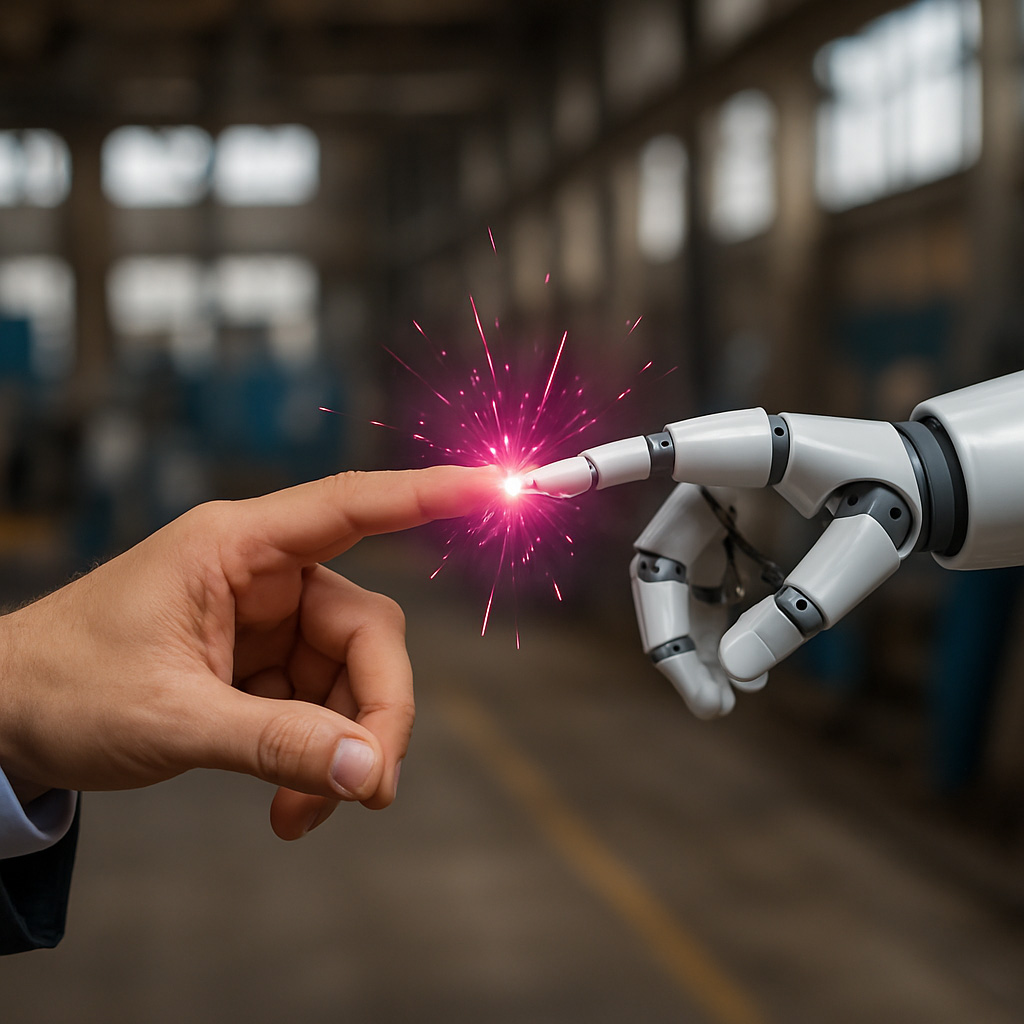4.7.2025
There’s a growing temptation to let algorithms handle more of our decision-making processes. After all, machines don’t get tired, they process vast amounts of data instantly, and they’re free from emotional bias. Yet the most successful leaders understand a fundamental truth: human-centered decision making remains irreplaceable in making choices that truly matter.
As leaders and managers, the choices we make ripple through our organizations, affecting teams, customers, and stakeholders. These choices affect in ways that extend far beyond spreadsheets and metrics. We can certainly enhance decision-making with technology, but removing humans from the equation can be dangerous. Here’s why keeping people at the center of your decision-making process isn’t just important, it’s essential for long-term success.
Human Judgment Brings Ethics and Context That No Algorithm Can Replace
When faced with complex organizational decisions, pure logic and data analysis often fall short. This is where human judgment becomes invaluable. It brings two critical elements that technology simply cannot replicate: ethical insight and contextual awareness.
Human beings possess an innate capacity for empathy, fairness, and moral reasoning that proves essential when making decisions that affect others. Consider a scenario where budget cuts might require layoffs. While an algorithm might efficiently identify which employees to let go based on productivity metrics alone, it cannot weigh the human cost—the single mother supporting her family, the employee nearing retirement, or the promising newcomer who just needs more time to develop. These ethical considerations require human judgment to navigate the complex moral landscape of organizational decision-making.
Beyond ethics, humans excel at grasping the subtleties of unique situations that algorithms consistently miss. Cultural nuances, emotional undercurrents, and situational factors don’t appear in data sets. But they can dramatically impact the success or failure of a decision. A human leader can recognize when a team is struggling with morale issues that might make a particular strategic direction problematic. Or when cultural sensitivities in a global organization require a more nuanced approach than what the data suggests.
Creativity and Innovation Cannot Be Automated
While artificial intelligence has made impressive strides in pattern recognition and data analysis, it remains fundamentally limited when it comes to true creativity and innovation. Human creativity emerges from our ability to make unexpected connections, challenge assumptions, and imagine possibilities that don’t yet exist in any dataset.
In brainstorming sessions and problem-solving scenarios, humans generate novel ideas and unexpected approaches that often prove to be game-changers. The breakthrough solution that transforms an industry rarely comes from optimizing existing processes—it comes from someone asking “what if we tried something completely different?” This kind of creative leap requires human imagination, intuition, and the willingness to venture into uncharted territory.
Moreover, only humans can truly envision future scenarios that extend beyond existing data patterns. Strategic planning and innovation require leaders who can imagine markets that don’t yet exist, customer needs that haven’t been articulated, and solutions to problems that haven’t been identified. This forward-thinking vision is uniquely human and absolutely critical for organizations that want to lead rather than follow.
Diversity of Perspectives Leads to Superior Decisions
One of the most compelling arguments for human-centered decision-making is the power of diverse perspectives. When multiple people contribute their unique viewpoints to a decision, the result is almost invariably more robust and comprehensive than what any single person—or machine—could produce alone.
Different team members bring varied experiences, expertise, and ways of thinking that can reveal hidden risks and opportunities. The marketing professional might spot potential customer reactions that the finance team missed. The front-line employee might understand implementation challenges that senior leadership hasn’t considered. The international team member might identify cultural factors that could make or break a global initiative.
This collective intelligence doesn’t just improve the quality of decisions—it builds shared understanding across the organization. When people from different backgrounds and roles contribute to a decision, they develop a deeper appreciation for the complexity of the challenges and the rationale behind the chosen solution. This shared understanding is crucial for successful implementation and long-term commitment to the decision.
Trust, Legitimacy, and Accountability Require Human Involvement
In today’s business environment, leaders can’t manufacture or automate trust and legitimacy—they must earn them. When teams make decisions transparently and involve everyone meaningfully, people naturally accept and commit to the outcomes.
When team members participate in the decision-making process, they tend to support and champion the final outcome, even if it wasn’t their preferred choice. This buy-in plays a crucial role in successful execution and organizational unity. People need to understand not just what the decision is, but also how and why the team made it—and what role they played in shaping it.
Human involvement also keeps accountability clear. Sometimes decisions fail. In those moments, it’s vital for identifiable people to take responsibility, learn from mistakes, and make necessary corrections. When organizations rely too much on automated decision-making, they often end up in situations where no one takes ownership of poor results—causing a culture of blame-shifting and diminished accountability.
Human Oversight Mitigates Technology’s Inherent Limitations
While technology excels in many areas, it struggles with ambiguity, exceptions, and novel situations that don’t fit established patterns. Human oversight provides the flexibility and adaptability that complex organizational decisions often require.
People are naturally equipped to handle gray areas and make judgment calls when the available information is incomplete or contradictory. They can recognize when a situation is truly unprecedented and requires a completely new approach. This flexibility is particularly valuable in dynamic business environments where conditions change rapidly and standard procedures may not apply.
Furthermore, maintaining active human involvement in decision-making helps preserve critical thinking and judgment skills within the organization. Over-reliance on automated systems can lead to a gradual erosion of these capabilities, leaving organizations vulnerable when technology fails or when situations arise that require uniquely human insight.
The Synergy of Human-Centered Decision Making and Structured Tools
The most effective decision-making doesn’t pit humans against technology—it combines the best of both. When structured tools support and amplify human collaboration, the results are faster, wiser, and more actionable decisions that benefit from both systematic analysis and creative human insight.
This synergy is particularly powerful because it addresses the weaknesses of each approach while leveraging their respective strengths. Technology can help organize information, facilitate communication, and ensure that important factors aren’t overlooked. Meanwhile, humans provide the creativity, ethical reasoning, and contextual understanding that technology lacks.
The key is finding the right balance—using technology to enhance human decision-making without replacing it entirely. This approach leads to decisions that are both analytically sound and humanly wise, with the added benefit of strong organizational commitment to implementation.
Read more: What is Collaborative Decision-Making?
How Noni Revolutionizes Human-Centered Decision Making
Recognizing the importance of human involvement in decision-making is one thing—but putting it into practice effectively presents an entirely different challenge. Noni bridges that gap by giving leaders a powerful platform that keeps humans at the center and helps teams overcome common obstacles to effective collaboration.
Noni’s approach to human-centered decision making relies on several key innovations that directly tackle those challenges. Noni allows people to raise ethical concerns and share contextual viewpoints safely through anonymous thought sharing and structured feedback collection, without fearing groupthink or hierarchical pressure. This approach creates a space where people feel confident sharing sensitive insights they might otherwise withhold.
With its thought gathering feature, Noni empowers everyone to contribute creative ideas independently before the group begins any discussion. This process prevents teams from narrowing their focus too early, as often happens in traditional meetings, and it encourages broader creative exploration. By separating individual ideation from group evaluation, Noni unlocks the full creative potential of diverse teams.
Noni also ensures that every voice counts. It collects and shows all input transparently, no matter people’s hierarchy or seniority. With tools like voting and ranking, Noni helps teams turn diverse perspectives into clear, shared priorities, allowing decisions to benefit from the full range of team insight and experience.
Most importantly, Noni makes documenting the decision-making process much easier. It helps teams organize their contributions and facilitates structured discussions, giving them a solid foundation for clear, comprehensive documentation of how they reached their decisions. This process makes decisions feel fair and legitimate to all participants. Rather than replacing human judgment, Noni amplifies it—helping teams structure their thinking, navigate complex situations together, and reach stronger outcomes.
Through step-by-step decision-making flows, Noni guides teams as they gather ideas, discuss options, and build consensus in a structured but flexible way. This method naturally blends systematic progress with human collaboration, leading to decisions that people understand, support, and commit to implementing.
Conclusion: The Human Advantage in an Automated World
As we advance further into the digital age, the temptation to automate decision-making will only grow stronger. However, the most successful leaders will be those who recognize that human-centered decision making—rooted in human judgment, creativity, and collaboration—remains an irreplaceable asset in making decisions that truly matter.
The goal isn’t to choose between human insight and technological capability—it’s to combine them strategically. By keeping humans at the center of your decision-making process through human-centered decision making, while leveraging tools that enhance collaboration and transparency, you create a powerful competitive advantage that pure automation simply cannot match.
The future belongs to organizations that can harness the full potential of their human capital. And use technology to amplify rather than replace human judgment. In this future, the leaders who thrive will be those who understand that the most important decisions are too important to be left to machines alone. They require the wisdom, creativity, and ethical reasoning that only humans can provide.




